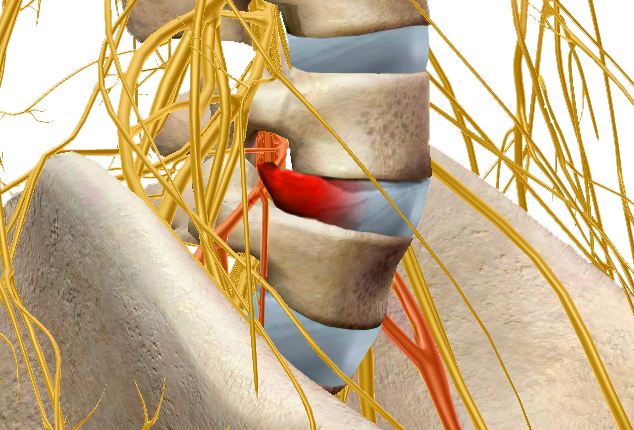
HERNIATED DISC
Table of Contents
INTERVERTEBRAL DISK
Between the vertebrae, from the second cervical vertebra C2 to the sacrum, are the intervertebral discs.
Each intervertebral disc is composed of an outer fibrous ring, the disc annulus (annulus fibrosus, or AF) and a soft inner substance (nucleus pulposus or NP).
Although the discs have very good resistance to direct pressure, they unfortunately do not tolerate rotational tension or types of excessive torsional forces.

HERNIATED DISC
Once the annulus fibrosus (FA) is degenerated or even damaged, causing swelling or even leaving the correct position of the pulposus nucleus (NP).
Herniated disc is common in men 30 to 50 years old, and it can appear very quickly, within 36 hours of the first cause.
SYMPTOMS OF HERNIATED DISC
- Backache, pain increases with flexion and decreases during extensions
- Muscle spasms
- Symptoms related to ponytail syndrome, in which attention should be paid to symptoms such as:
- Inability to urinate
- The bladder is full and is leaking
- Gradual loss of sensitivity between the legs
- Gradual loss of sensitivity and power in both legs
A disc of the cervical vertebrae also functions as a lumbar disc herniation. Symptoms may include neck pain and spasms, altered sensation in the hands, and weak fists
CAUSES OF HERNIATED DISC
- Any bad change, such as degeneration or damage to two components of the disc, the annulus fibrosus (AF) and the nucleus pulposus (NP), can cause a herniated disc.
- Accidents, such as falls, injuries caused by twisting or lifting movements, etc. can also cause a herniated disc.
- In addition, the reason for a herniated disc is simply coughing or sneezing in some people with poor physical conditions, an elderly or a sick person.
PREVENTIONS OF HERNIATED DISC
Here are the precautions to reduce the risk of herniated disc:
- Exercise regularly, improve physical health, improve flexibility of the spine, improve balance and coordination of the body.
- Prevent and eliminate the accumulation of stress caused by prolonged and repeated types of activity
- Always maintain good posture, correct movement to protect the spine and internal organs.
- Avoid overweight, apply measures to lose weight in the event of overweight.
- Wear suitable low heel shoes to minimize pressure on your spine
TREATMENTS OF HERNIATED DISC
The following treatments apply to acute hernias but do not fall into an emergency situation (“red flag”).
- Limit activities, but do not rest in bed if this is not yet a serious case. In severe cases, do not stay more than 48 hours.
- Apply heat therapy to affected areas to reduce muscle spasms and pain.
- Take medications, such as pain relievers and anti-inflammatories. Be careful when using narcotic pain relievers
- Do light exercises (excluding exercises with bends), with the advice of qualified physiotherapists or health professionals. Combining well with the process of relaxation, rest.
- Practice correct posture of walking, standing, sitting, lying and moving.
- The injection of steroids, discestomy and chemonucleolysis (i.e. putting an enzyme called chymopapain derived from papaya into the pulposus nucleus with a needle), to dissolve the pulposus nucleus which reduces its pressure on nerves) are the least invasive options that can be considered in special cases.
In the case of a mild to moderate cervical disc problem, a soft and flexible cervical collar around the neck, which can support the neck, may also be prescribed to limit mobility and overload of the neck.
USE CAUTION WHEN TREATING A HERNIATED DISC
During the acute phase of a herniated disc, treatments such as chiropractic and massage are not recommended.
TREATMENTS OF HERNIATED DISC ALTERNATELY
- Acupuncture or acupoint therapies are recommended
- If smoking, stop
- Yoga and tai chi are always excellent for helping patients practice self-improvement, improve and maintain flexibility, balance and body coordination.
- Practice training and maintaining the correct body posture in all forms of movement and activities.
EXERCISES TO PREVENT AND CURE A HERNIATED DISC
Here are some exercises that VIKUDO recommends, for people with lumbar disc hernias that can be applied:
Yoga VT13 _ Prevent and treat Lumbar herniated disc _ P1
Yoga VT14 _ Prevent and treat Lumbar herniated disc _ P2
THINGS TO KNOW WHEN YOU HAVE URGENT BACK PAIN
And, you should also refer to this article for more information regarding back and neck pain, along with appropriate ways to deal with situations:
